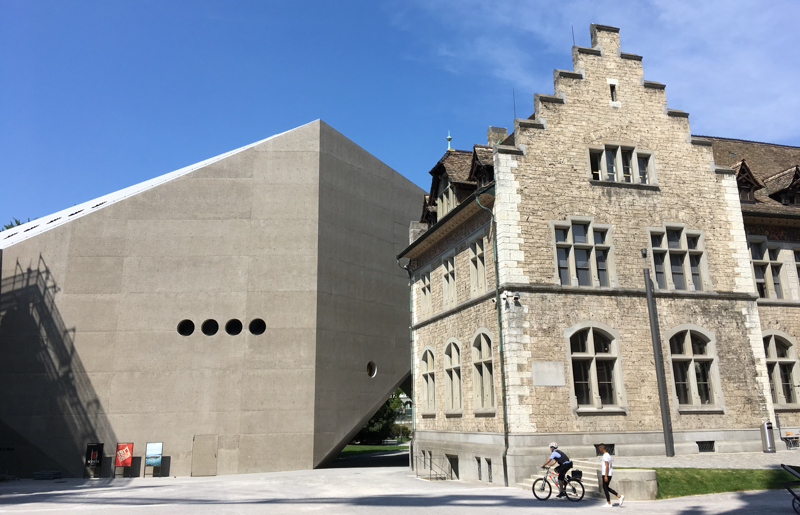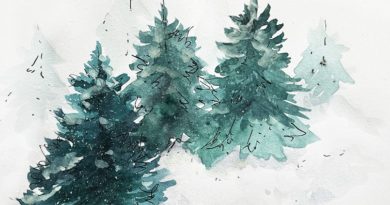The Swiss National Museum and the Museum of Appenzell Customs
On a cold, snowy April day, I was reading the “Tage” (Tages Anzeiger, a Zurich city newspaper), when I came across an article about the Swiss and their museums. I was surprised to read that the Swiss are museum-visiting champions. The average Swiss person visits a museum at least once a year. They clock more museum visits than cinema visits or amusement park visits; play, opera or ballet visits. Amazingly enough, most Swiss enjoy museum visits, and these numbers aren’t related to income or educational level or cultural background; it is just something they grow up doing and continue doing into adulthood. Could Swiss school programs be responsible? Or, as I asked myself that Sunday, the often extremely fickle weather? Perhaps it is simply the sheer number of museums available? Museums are grand or tiny, comprehensive or limited in scope, yet their numbers are mind-boggling when you consider the country’s size. I still don’t know why most Swiss enjoy museums, but this knowledge does help me understand why my Swiss husband and (especially) my kids never turn down a chance to meander through a museum on a rainy or sunny day.
This spring, my family and I visited two Swiss museums that might help you and your family to understand why the Swiss love museums: the Landesmuseum (Swiss National Museum) in Zurich and the Appenzeller Brauchtumsmuseum (Museum of Appenzell Customs) in Urnäsch.
Although both museums focus on Swiss culture, they could not be more different. The Swiss National Museum is a comprehensive cultural history museum situated in a grand building combining gothic and contemporary architectures, located along the Limmat river in Zurich. The Museum of Appenzell Customs is on the opposite end of the spectrum, a cozy museum without heating – if you can believe that – focusing on the seemingly primitive and often pagan culture of traditional Eastern Swiss Appenzellers. There is one other thing they have in common: they both showcase and document the influence of immigration in Switzerland. With all of the conflict arising today about borders and movement of people, a visit to these museums provides you and your family with the Swiss historical view on this topic.

The Landesmuseum, or Swiss National Museum
This cultural history museum is centered around the history of migration and settlement, religion and intellect, and the political and economic development of Switzerland. The exhibits about migration and settlement are not only historically relevant but also pertinent today. None of us can escape the debate in Switzerland, as in most countries, about immigrants: letting them in or forcing them out. The museum deals with this topic. Of course, this is related to religion and intellectual changes as well as political and economic development too, which is reflected in the exhibits. Young kids love the myth of Wilhelm Tell and the famous battles fought to keep foreign occupiers out of Switzerland. There is enough for young and old to see and touch!

I suggest, if you have teens, that you also spend time in the current special exhibit “The Revolution of 1917. Russia and Switzerland,” which commemorates the 100-year anniversary of that revolution. The comprehensive and fascinating exhibit emphasizes the historical relationship between the two countries, those individuals who gained asylum as well as the workers’ movement in general. Then, as now, Switzerland often acted to grant political asylum to dissidents as well as to allow selected immigrants. Prior to the 1917 Revolution, Vladimir Lenin and Leo Trotsky were allowed to live in Bern and Geneva, respectively. One aspect of the exhibit focuses on Zimmerwald, a small village where 38 socialist pacifists, including Lenin and Trotsky, met to plan to end World War I. Their secret plan and disguises are revealed. Additionally, there is an exciting collection of objects ranging from a precious Fabergé egg created for the Russian Czar Nicholas, to uniforms designed for comrades.

Another new exhibit that addresses movement of people is the permanent exhibit about the archaeology of Switzerland. There are beautifully constructed displays of the archaeological remains of former cultures who once populated Switzerland: the lake dwellers, Celts, and the Alemanni. A visit to this museum gives wonderful insight into the cultural history of Switzerland and human migration.
The museum has English documentation and includes a lovely gift shop – we just had to buy a poster about the Revolution. The Swiss National Museum is easy to reach, located across from the main train station in Zurich.
Temporary exhibits
24.02.2017 to 25.06.2017
“The Revolution of 1917. Russia and Switzerland”
Permanent exhibits
The History of Switzerland
Archaeology in Switzerland
The Collections Gallery
Costs: Adults SFr. 10; children younger than 16, free admission. Discounts are offered.
The museum also offers tours, audio guides (free), and public lectures in German.
The Brauchtumsmuseum, or Museum of Appenzell Customs
The lovely, quaint Museum of Appenzell Customs is at first glance a trip to the past farming and cattleman culture very special to the Appenzell. Cowbells are on display; you can make music with an antique Hackbrett or swing a five-franc coin in special bowls that have been used in homes for generations to make eerie music, or view a replica of an alpine hut with all the cheese-making equipment that has been used over the centuries. There is a movie in English which describes the pagan rituals continuing today such as the Silvesterchläuse or the Bloch – all very traditional and appearing insularly “Swiss.” There is even a charming painting or two by the late Albert Manser, a famous children’s book author. At second glance, you will notice just how difficult life was for the people living in this region. And, in the new exhibit about textiles for instance, you can’t help but notice the reliance of the culture on foreign workers. Immigrants from Italy and Spain came to Switzerland to work and then stayed. Although the displays were in German, they were quite easy to understand. You can still enjoy the tactile exhibits quite well without language knowledge. There is a nice play area with related hands-on activities for young children.
Here is a link to the museum’s website, in German.
Temporary Exhibit: “Textile Work – Passion or Fate?” (Textilarbeit – Leidenschaft oder Schicksal?)
Opening times:
Monday through Saturday: 9:00-11:30, 13:30-17:00; Sunday: 13:30-17:00
Entrance fees: Adults SFr. 6, children ages 6 to 16: SFr. 3; discounts for various card-holders
By Dr. Teresa Bingham Müller
Teresa is a geologist and educator who currently works as an instructor and science editor. She has three sons ages 18, 21, and 34, and two grandchildren.
Photos by Sebastian Müller




